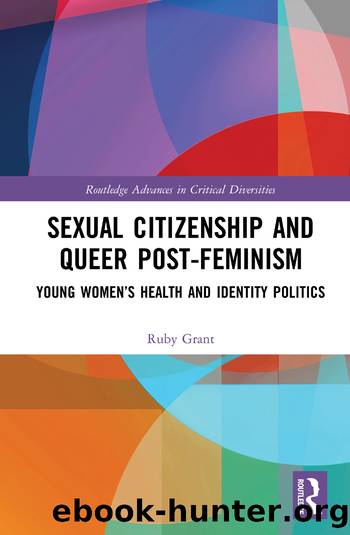Sexual Citizenship and Queer Post-Feminism by Ruby Grant

Author:Ruby Grant [Grant, Ruby]
Language: eng
Format: epub
Tags: Health & Fitness, Sexuality, Social Science, Feminism & Feminist Theory, Sociology, General
ISBN: 9781000171136
Google: JszxDwAAQBAJ
Publisher: Routledge
Published: 2020-08-05T03:51:34+00:00
I still have no idea whether Iâm supposed to get a pap smear or not ⦠It was really unclear and Iâve since been told all sorts of stuff ⦠like, different stuff from different people. So Iâve got no idea. Itâs that sort of thing â we just arenât taught this stuff, so often we only find stuff out when itâs too late.
(Harley, 19, asexual, agenderflux)
Large studies of Australian secondary school students reveal same-sex attracted young people are sexually active earlier on average than heterosexual young people (see Hillier and Mitchell 2008; Smith et al. 2011). Lesbian, bisexual, and queer young women often discover their same-sex attractions at a later age, but report higher rates of heterosexual behaviour than same-sex attracted young men (Dempsey et al. 2001: 67â68). Given these experiences, it is concerning that queer young women and non-binary people are likely to disengage from heteronormative school-based SRE, seeing it as irrelevant to their experiences (âItâs all just for straight peopleâ), and instead learn by experimentation.
The detrimental impact of inadequate sexuality-affirming SRE and health information for LGBTIQ communities is well documented (see Formby 2011; Hillier and Mitchell 2008; Jones and Hillier 2013; Shannon 2016); however, I argue that this is especially isolating for bisexual and queer young women and non-binary people in rural and regional areas like Tasmania. Tasmanian gay men are less likely than those in Victoria and New South Wales to have been tested for HIV and are more likely to access sexual health information and social support online (Lea et al. 2015). Lea et al. (2015) also suggest that a lack of queer visibility limits LGBTIQ Tasmaniansâ access to inclusive sexuality and sexual health information. I posit that similar circumstances shape Tasmanian queer women and non-binary peopleâs understandings and experiences of sexuality and sexual health. In the extract above, Jess raised the important point that it is only as an adult engaged in âthe gay sceneâ that she has learned about queer sexual health. This sentiment is common among participants; however, given the limited scene in Tasmania, especially in areas outside of Hobart, the participants stressed the need for more comprehensive school-based SRE and public health promotion specific to bisexual and queer women and non-binary peopleâs experiences in Tasmania.
However, as I will discuss in more detail in Chapter 4, many of the people I spoke to found it difficult to imagine what sexual health promotion might look like for queer women and non-binary people. What does âsafe sexâ even mean in the context of sex between AFAB partners? Because safe sexual scripts are so medicalised and centred on heterosexuality, even queer women themselves can find this hard to fathom. Stella told me that while sexual health promotion for gay menâs health can be as simple as throwing condoms out into the crowd at the local gay bar, the same is not true for women and AFAB non-binary people. Laughing over lunch, Stella said she once went to an event at a gay bar where dental dams were handed out and at the end of the night the dancefloor was scattered with discarded dams.
Download
This site does not store any files on its server. We only index and link to content provided by other sites. Please contact the content providers to delete copyright contents if any and email us, we'll remove relevant links or contents immediately.
On the Front Line with the Women Who Fight Back by Stacey Dooley(4800)
The Rules Do Not Apply by Ariel Levy(4797)
The Lonely City by Olivia Laing(4715)
Bluets by Maggie Nelson(4439)
The Confidence Code by Katty Kay(4166)
Three Women by Lisa Taddeo(3329)
Not a Diet Book by James Smith(3302)
Inferior by Angela Saini(3215)
Confessions of a Video Vixen by Karrine Steffans(3213)
A Woman Makes a Plan by Maye Musk(3179)
Pledged by Alexandra Robbins(3106)
Wild Words from Wild Women by Stephens Autumn(3047)
Nice Girls Don't Get the Corner Office by Lois P. Frankel(2976)
Brave by Rose McGowan(2766)
Women & Power by Mary Beard(2693)
Why I Am Not a Feminist by Jessa Crispin(2670)
The Girl in the Spider's Web: A Lisbeth Salander novel, continuing Stieg Larsson's Millennium Series by Lagercrantz David(2649)
The Clitoral Truth: The Secret World at Your Fingertips by Rebecca Chalker(2635)
Women on Top by Nancy Friday(2494)
